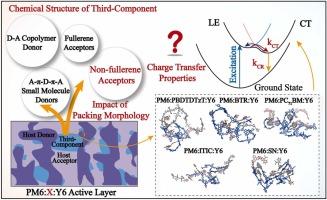Ternary Organic Solar Cells: Third-component Effect on Molecular Packing and Charge Transfer Properties
IF 17.1
1区 材料科学
Q1 CHEMISTRY, PHYSICAL
引用次数: 0
Abstract
Besides conventional photovoltaic properties, molecular engineering plays an important role in enhancing the synergy among components and maximizing the performance of ternary organic solar cells (TOSCs). Here, molecular dynamics simulations and long-range corrected density functional theory calculations are combined to examine the impact of several third-component structures on molecular packing and charge transfer properties in PM6:X:Y6 blends. SN exhibits superior miscibility in PM6:Y6 blend and forms an alloy-like structure with Y6, effectively promoting the formation of dimer/trimer donor-acceptor complexes. This contributes to the significant enhancement of exciton dissociation and reduction of non-radiative voltage losses (ΔVnr). Meanwhile, electron delocalization on the SN_Y6 alloy modulates the LUMO levels of the trimer complexes, lowers exciton binding energy, and contributes to a further reduction of non-radiative recombination. However, other third-component structures exhibit modest efficiency in optimizing donor-acceptor mixing, leading to inefficient dimer/trimer complex formation, limited contribution to exciton dissociation enhancement, and a restricted ability to reduce ΔVnr. This work provides valuable insights for the rational selection of third-component materials to enhance the performance of TOSCs.

三元有机太阳能电池:第三组分效应对分子堆积和电荷转移性能的影响
除了传统的光伏特性外,分子工程在增强组件之间的协同作用和最大化三元有机太阳能电池(TOSCs)性能方面也起着重要作用。本文将分子动力学模拟和远程校正密度泛函理论计算相结合,研究了几种第三组分结构对PM6:X:Y6共混体系中分子堆积和电荷转移性能的影响。SN在PM6:Y6共混物中表现出优异的混溶性,与Y6形成类似合金的结构,有效促进了二聚体/三聚体供体-受体配合物的形成。这有助于显著增强激子解离和减少非辐射电压损失(ΔVnr)。同时,SN_Y6合金上的电子离域调节了三聚体配合物的LUMO水平,降低了激子结合能,有助于进一步减少非辐射复合。然而,其他第三组分结构在优化供体-受体混合方面表现出适度的效率,导致二聚体/三聚体复合物的低效形成,对激子解离增强的贡献有限,并且降低ΔVnr的能力有限。这项工作为合理选择第三组分材料以提高tosc的性能提供了有价值的见解。
本文章由计算机程序翻译,如有差异,请以英文原文为准。
求助全文
约1分钟内获得全文
求助全文
来源期刊

Nano Energy
CHEMISTRY, PHYSICAL-NANOSCIENCE & NANOTECHNOLOGY
CiteScore
30.30
自引率
7.40%
发文量
1207
审稿时长
23 days
期刊介绍:
Nano Energy is a multidisciplinary, rapid-publication forum of original peer-reviewed contributions on the science and engineering of nanomaterials and nanodevices used in all forms of energy harvesting, conversion, storage, utilization and policy. Through its mixture of articles, reviews, communications, research news, and information on key developments, Nano Energy provides a comprehensive coverage of this exciting and dynamic field which joins nanoscience and nanotechnology with energy science. The journal is relevant to all those who are interested in nanomaterials solutions to the energy problem.
Nano Energy publishes original experimental and theoretical research on all aspects of energy-related research which utilizes nanomaterials and nanotechnology. Manuscripts of four types are considered: review articles which inform readers of the latest research and advances in energy science; rapid communications which feature exciting research breakthroughs in the field; full-length articles which report comprehensive research developments; and news and opinions which comment on topical issues or express views on the developments in related fields.
 求助内容:
求助内容: 应助结果提醒方式:
应助结果提醒方式:


